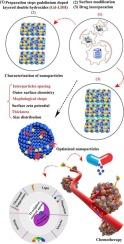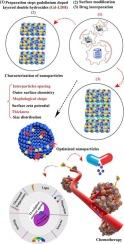开发基于钆层双氢氧化物的治疗纳米平台,用于磁共振成像引导的刺激增强化疗
IF 20.3
1区 化学
Q1 CHEMISTRY, INORGANIC & NUCLEAR
引用次数: 0
摘要
无创可视化和精确治疗癌症的要求一直在不断提高,这就要求我们不断努力,加强强效治疗模式的开发。值得注意的是,纳米技术的突破性进展已将层状双氢氧化物(LDH)置于生物医学研究的最前沿。层状双氢氧化物载体能够整合多种模式的优势,从而为临床应用铺平道路,因此在医药应用中备受推崇。最近在治疗学合理设计方面取得的突破凸显了掺杂钆(Gd)的 LDH 的潜力,这种 LDH 尤其适用于疾病诊断。本综述着重全面概述了 Gd-LDH 组装在癌症治疗学中的最新重大进展,重点介绍了自下而上的插层策略、影响因素和制剂方法。这些方面对于开发创新插层工艺和新型多组分材料的研究人员至关重要。此外,我们还讨论了钆插层 LDH 的动力学惰性和胶体稳定性,这对于先进的治疗应用至关重要。最后,我们对与 Gd-LDH 复合物相关的挑战和未来机遇进行了前瞻性讨论,旨在找出研究人员在推进 Gd-LDH 临床应用时遇到的障碍,并为进一步研究提供潜在的见解。本文章由计算机程序翻译,如有差异,请以英文原文为准。


Development of theranostic nanoplatforms based on gadolinium-layered double hydroxides for magnetic resonance imaging-guided stimuli-enhanced chemotherapy
The requirements for non-invasive visualization and precise treatment of cancers are ongoing, demanding continuous efforts to enhance the development of potent theranostic modalities. Notably, groundbreaking advancements in nanotechnology have positioned layered double hydroxides (LDHs) at the forefront of biomedical research. LDH carriers are highly valued in medicinal applications due to their ability to integrate the benefits of multiple modalities, thus paving a promising path to clinical use. Recent breakthroughs in the rational design of theranostics have underscored the potential of gadolinium (Gd)-doped LDHs, which are particularly well-suited for the diagnosis of diseases. This review focuses on providing a comprehensive overview of the latest significant advances in Gd-LDH assemblies in cancer theranostics, with an emphasis on a bottom-up intercalation strategy, influential factors, and formulation methodologies. These aspects are crucial for researchers developing innovative intercalation processes and novel multi-component materials. Additionally, we address the kinetic inertness and colloidal stability of Gd-intercalated LDHs, which are essential for advanced theranostic applications. Finally, we present a forward-looking discussion on the challenges and future opportunities related to Gd-LDH complexes, aiming to identify the obstacles researchers encounter in advancing the clinical application of Gd-LDHs and to offer potential insights for further research.
求助全文
通过发布文献求助,成功后即可免费获取论文全文。
去求助
来源期刊

Coordination Chemistry Reviews
化学-无机化学与核化学
CiteScore
34.30
自引率
5.30%
发文量
457
审稿时长
54 days
期刊介绍:
Coordination Chemistry Reviews offers rapid publication of review articles on current and significant topics in coordination chemistry, encompassing organometallic, supramolecular, theoretical, and bioinorganic chemistry. It also covers catalysis, materials chemistry, and metal-organic frameworks from a coordination chemistry perspective. Reviews summarize recent developments or discuss specific techniques, welcoming contributions from both established and emerging researchers.
The journal releases special issues on timely subjects, including those featuring contributions from specific regions or conferences. Occasional full-length book articles are also featured. Additionally, special volumes cover annual reviews of main group chemistry, transition metal group chemistry, and organometallic chemistry. These comprehensive reviews are vital resources for those engaged in coordination chemistry, further establishing Coordination Chemistry Reviews as a hub for insightful surveys in inorganic and physical inorganic chemistry.
 求助内容:
求助内容: 应助结果提醒方式:
应助结果提醒方式:


